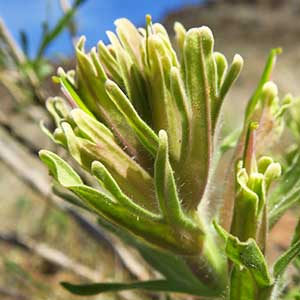Castilleja xanthotricha
Castilleja chromosa
John Day or yellow-hairy paintbrush, John Day paintbrush, yellow hair paintbrush, yellow-hair Indian paintbrush
desert paintbrush
few to several, ± decumbent to erect or ascending, unbranched, sometimes with short, leafy axillary shoots, hairs erect to spreading, long, soft, eglandular, mixed with short stipitate-glandular ones.
several to many, ascending to erect, often grayish, unbranched, rarely branched, sometimes with short, leafy axillary branches, hairs spreading-erect, long, stiff, eglandular, sometimes also with shorter, stipitate-glandular ones.
green, linear, lanceolate to broadly lanceolate, oblong, or cuneate, 0.8–5 cm, not fleshy, margins plane to wavy, involute, 0–5-lobed, apex acute, sometimes rounded;
lobes spreading, linear, arising below mid length, nearly as broad as center lobe, apex acute.
gray-green, linear, lanceolate, or oblanceolate, sometimes broadly lanceolate, (1.5–)2.5–6(–7) cm, not fleshy, margins plane, involute, (0–)3–5(–7)-lobed, sometimes with secondary lobes, apex acuminate to obtuse;
lobes spreading, linear, apex acuminate.
3–14 × 1.5–4.5 cm;
bracts proximally greenish, rarely dull reddish purple, distally white to cream, rarely pale yellow or dull, pale pink (sharply differentiated from proximal coloration), lanceolate or oblong to narrowly ovate, (3–)5–7-lobed;
lobes ascending, linear to obovate, ± broadened distally, medium, long, proximal lobes arising below mid length, central lobe apex broadly rounded to truncate, others acute to rounded.
2.5–15 (much longer in fruit) × 1.5–5.5 cm;
bracts proximally greenish to dull purplish, distally bright red to scarlet or orange-red, rarely yellowish to dull orange or pink, narrowly to broadly linear or lanceolate, narrowly ovate, or oblong-lanceolate, (0–)3–7-lobed, rarely with secondary lobes;
lobes spreading, linear to oblong, sometimes oblanceolate, often expanded near tip, long, proximal lobes arising below mid length, apex rounded or obtuse to sometimes acute.
curved, 17–23 mm;
tube 15–19 mm;
beak exserted, adaxially green, 5–8(–9) mm, puberulent, stipitate-glandular;
abaxial lip deep purple (color sometimes visible through calyx), green, pinkish, or pale yellow, ± prominent, slightly inflated, usually hidden in calyx, sometimes right at top of calyx, 2 mm, ca. 50% as long as beak;
teeth ascending, whitish, yellowish, pink, or green, 1–1.5 mm.
straight or ± curved, 18–35(–40) mm;
tube 8–15 mm;
beak short- or long-exserted, adaxially green to yellow-green, (9–)10–18 mm;
abaxial lip deep green, reduced, thickened, included to exserted, 2–3 mm, ca. 20% as long as beak;
teeth incurved, deep green, 0.5–1 mm.
colored as bracts, 15–26 mm;
abaxial and adaxial clefts 3.5–7 mm, 25–50% of calyx length, deeper than laterals, lateral 2–5 mm, 12–25% of calyx length;
lobes linear, oblong, or narrowly triangular, center lobe apex usually rounded, lobes acute to rounded.
colored as bracts, sometimes with broad yellow band below colored lobe apices, (17–)20–27 mm;
abaxial clefts 4–10 mm, adaxial 6–12 mm, abaxial ca. 30% of calyx length, adaxial ca. 40% of calyx length, deeper than laterals, lateral 1–4 mm, ca. 15% of calyx length;
lobes oblong or ovate to narrowly triangular or lanceolate, apex obtuse to rounded.
= 48.
= 24, 48.
Castilleja xanthotricha
Castilleja chromosa
Castilleja xanthotricha is endemic to moderate elevations in the sagebrush hills of the John Day River drainage in north-central Oregon. N. H. Holmgren (1971) hypothesized that this tetraploid species is of allopolyploid hybrid origin between C. glandulifera and C. oresbia.
(Discussion copyrighted by Flora of North America; reprinted with permission.)
Castilleja chromosa is sometimes confused with 3b. C. angustifolia var. dubia (see discussion there). Castilleja chromosa retains its distinctive morphology across its wide range and is a characteristic species of much of the southwestern United States. Where it overlaps with C. angustifolia, the two are distinguished by inflorescence color and width and by the lengths of the calyx, corolla, and corolla beak. In the broad region of their sympatry, there is little evidence of intergradation, except in a few sites in Elko County, Nevada, and in southern Wyoming. Throughout southern Idaho and northeastern Nevada the range of the two overlap with little or no intergradation. At high elevations in Montrose County, Colorado, C. chromosa has narrower leaves and a longer and silkier pubescence, especially in the inflorescence. Apparent hybrids between C. chromosa and C. flava var. rustica are known from Custer County, Idaho, and hybrids with C. linariifolia are known from Montrose County, Colorado.
(Discussion copyrighted by Flora of North America; reprinted with permission.)
